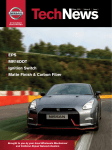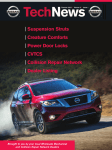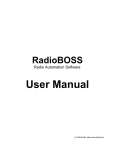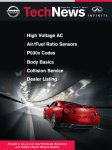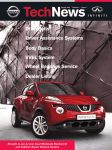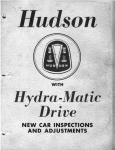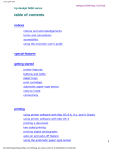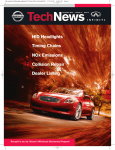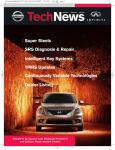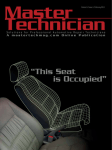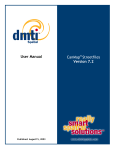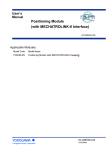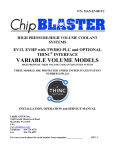Download Keeping Cool Under Pressure
Transcript
TechNews Winter 2014 | Volume 7 | Issue 1 | Cutting the Cable | Keeping Cool | Wiring Matters | Nissan and OBD Brought to you by your local Wholesale Mechanical and Collision Repair Network Dealers ® Who Decides What’s Right for YOUR Business? Generic Insurance Company Collision Repair Professional Dictate Parts Usage Pay Least Possible Use OEM Parts as Last Resort Squeeze Shop Profits Quality OEM Parts Quality Repairs Customer Satisfaction Sustainable Business Don’t get squeezed. Take control and do what’s right for your shop and your customers. Your customers deserve the precision fit, function and structural integrity of parts designed by Nissan. Nissan’s Market Shield program helps provide the competitive pricing you expect. Don't settle for anything less than Genuine Nissan Parts. The Nissan Market Shield program is powered by: parts.NissanUSA.com Nissan Tech News | Winter 2014 | Volume 7 Issue 1 Nissan Tech News is a publication of Nissan North America. No part of this newsletter may be reproduced without the express written permission of Nissan North America. Group Publisher Christopher M. Ayers Jr. [email protected] Editorial Director Bob Freudenberger [email protected] Managing Editor Tom Nash [email protected] Contributing Editors Bob Chabot [email protected] Paul Cortes [email protected] Phil Fournier [email protected] Christian Strohm [email protected] Art Director Christopher Ayers III [email protected] Nissan North America Project Manager Leslie Ohrin [email protected] | Contents Features 04 | Cutting the Cable A look at Nissan’s Electronic Throttle Control System and its components, including a discussion on the advantages of the design, as well as some diagnostic considerations that underscore the importance Nissan has given to reliability. 10 | K eeping Cool There is no such thing as a maintenancefree cooling system. It’s important to identify potential problems and catch them before a break-down situation. Let’s explore Nissan’s various engine cooling systems, the importance of proper fluids, and some best-practice inspection techniques. 18 | Wiring Matters Network topology, wiring diagrams and scan tools are essential for modern collision repair. Nissan North America Technical Content Advisors Dave Willson [email protected] James Von Ehr [email protected] Editorial and Circulation Offices: 134B River Road Montague, NJ 07827 Phone: 330.620.3929 www.automotivedatamedia.com Caution: Vehicle servicing performed by untrained persons could result in serious injury to those persons or others. Information contained in this publication is intended for use by trained, professional auto repair technicians ONLY. This information is provided to inform these technicians of conditions which may occur in some vehicles or to provide information which could assist them in proper servicing of these vehicles. Properly trained technicians have the equipment, tools, safety instructions, and know-how to perform repairs correctly and safely. If a condition is described, DO NOT assume that a topic covered in these pages automatically applies to your vehicle or that your vehicle has that condition. 04 | Nissan and OBD An overview of Nissan OBD II, and why the CONSULT is superior when compared to generic scan tools for diagnosing problems on Nissan vehicles. Departments | 27 Nissan Dealer Listings Winter 2014 | 3 Feature Cutting the Cable: Nissan Electronic Throttle Control A look at Nissan’s Electronic Throttle Control System and its components, including a discussion on the advantages of the design, as well as some diagnostic considerations that underscore the importance Nissan has given to reliability. 4 | Nissan TechNews As we in the industry all know, there is no such thing as a “gas pedal,” but rather a pedal that controls air flow into the engine. Traditional designs connect the accelerator pedal directly to a valve within the throttle body using linkage or a cable. When the driver’s foot is off the pedal, the “butterfly” valve is closed against its stop. You will find an Idle Air Control Valve (IACV) or a similar auxiliary air-input path that the ECU can use to bypass the throttle plate. These days, all Nissan vehicles come equipped with fully electronic throttle control systems, and this article will introduce you to Nissan’s implementation of throttle-by-wire. How it Works In the most common throttle-by-wire design from Nissan, instead of a cable there is an electronic throttle valve actuator that is commanded by the ECU and physically opens or closes the throttle valve. Because there is no cable tension, position sensors located on the accelerator pedal and on the throttle actuator give equivalent data to the ECU. When the driver moves the accelerator pedal, the Accelerator Pedal Position sensor (APP) reports the movement to the ECU, which then commands the throttle valve actuator to rotate the throttle plate open or closed. Instead of a secondary idle valve, the ECU can control the throttle plate as needed to regulate idle. The location of the throttle plate is reported by the Throttle Position Sensor (TPS) and is some percentage of a 5V reference. The ECU learns over time what the throttle plate position should be at idle. This learning capability allows the ECU to accommodate unavoidable changes to air intake flow from carbon build-up or other restriction. There is no way for a technician to manipulate “base idle” on this system as you used to do with a traditional idle screw. The learned position can be lost when computer memory is lost, so be mindful of this fact when disconnecting the battery for repairs. CONSULT III plus can be used to recalculate base idle using the WORK SUPPORT section. Bulletproof Reliability Throttle-by-wire is a phrase borrowed and changed from the aeronautical industry’s “flyby-wire” concept. Modern airplanes replace hydraulic lines with computer-controlled localized servos, actuators, or motors. If it’s safe enough for airplanes, the technology is ready for vehicles. Many people are concerned about the reliability of throttle-by-wire systems, especially if a failed TPS or APP means a loss of accelerator control. Nissan eliminates this fear by engineering these vital systems with duplicate sensors for error detection and fail-safe operation. Nissan’s fail-safe includes two separate position sensors for both the accelerator pedal assembly and the throttle body valve. The TPS is made up of two separate sensors, each bringing down the 5V reference coming from the ECU. In the event that one position sensor malfunctions, the secondary position sensor will provide the data necessary for safe operation, as well as provide the rational baseline for comparison and error checking. Likewise, the APP has two distinct sensors that report two different potential voltages for accelerator position. The ECU can monitor for logical malfunctions when one sensor reports outside of its capabilities. Put simply, your customers are not going to have a reliability concern when it comes to throttle-bywire. It would require two separate potentiometers within each sensor to fail simultaneously, or a wiring harness failure to create a drivability malfunction. The master warning indicator will illuminate if a problem is detected. Advantages Despite the complications involved with learning and understanding new technology, Nissan recognizes the importance of throttle-by-wire for current and future engine management. Let’s discuss some of the major advantages of a system that replaces the throttle cable and idle air control motor design. Winter 2014 | 5 Cutting the Cable Diagnosis and Work Support Like anything else on a car, it is possible for a throttle-by-wire component to require service. Diagnosis and adjustments are performed with the CONSULT III plus. While it is technically possible to do some repairs on some vehicles by following the Nissan repair manual and placing the vehicle 6 | Nissan TechNews Throttle Position Sensor 6.0 Sensor 1 Volts 4.0 2.0 Sensor 2 0 45 90 135 Throttle valve opening angle (deg) Note the range of throttle position sensor voltages for normal behavior in this graph. Accelerator Pedal Position (APP) Sensor Accelerator pedal position sensor output voltage First, there is no auxiliary idle control valve that can become restricted or malfunction. Likewise, there are no external moving parts like a cable or spring that could develop mechanical issues from weather or wear. Also, engine performance is improved because the ECU can snap to 100% throttle faster than a pedal could pull the cable through its full travel. If the speed of the accelerator pedal is determined to be great enough, the computer can extrapolate that the user command is WOT and provide it more quickly than the driver’s foot ever could. Likewise, the ECU can normalize slight pedal travel variations and improve fuel economy by smoothing out acceleration. You will notice this normalization distinctly when feathering the throttle to engage the clutch of a manual transmission. In fact, the idle control behavior will raise throttle as the engine approaches stalling when engaging the clutch in first gear making that catch point throttle feathering technique obsolete. Above all, throttle-by-wire enables the advanced cruise control and safety features of vehicle stability control. On Nissan vehicles equipped with Intelligent Cruise, the computer is capable of adjusting the throttle up and down to match speeds with another vehicle detected by its range-finding lasers. If the vehicle is equipped with Distance Control ASSIST (DCA) or Backup Collision Intervention (BCI), the throttle pedal will actually attempt to push up the accelerator if it detects an imminent threat, prompting the driver to move his foot from the gas pedal to the brake. ABS and vehicle stability control will override driver-requested throttle input when a slip is detected. Suffice it to say that each of these advanced systems have already been the sole subject of entire Nissan Tech News articles due to their complexity. 6.0 Sensor 1 4.0 2.0 Sensor 2 0 45 90 135 Accelerator pedal opening angle (deg) Here’s the range of accelerator pedal position voltages. into a diagnostic mode, this method is much more difficult and cannot be used for all repairs. It is best to get the proper scan tool for the job. When intake air parameters are reset, either by ECU replacement or updating, it may be necessary to recalibrate the existing throttle-by-wire components. Follow the Nissan repair manual for ECU replacement on the particular vehicle you are servicing. For the 2011 Altima, the throttle-by-wire components will have to “relearn” their positions. Perform the following procedures in this order: 1.Accelerator pedal released position learning 2.Throttle valve closed position learning 3.Idle air volume learning These procedures are found in the repair manual. Accelerator pedal position is learned on this Altima by toggling the ignition switch ON for two seconds, followed by 10 seconds of OFF, then repeating the process. Throttle valve closed position is learned by using the CONSULT III plus, navigating to WORK SUPPORT, and choosing the CLSD THL POS LEARN button. This must be done with the engine cold (ECT < 77 deg. F.). Idle air volume relearn is the last step because it requires the engine to be at operating temperature. Turn off all accessories and allow the vehicle to idle. Using CONSULT III plus, navigate again to WORK SUPPORT and choose IDLE AIR VOL LEARN. Press start, and after about 20 seconds, the idle volume learn will be complete. You may be required to perform some or all of the above procedures when replacing a particular component. For example, the same Altima requires #2 and #3 to be done after replacing the Electronic Throttle Control Actuator. Because Nissan has an in-house remanufacturing program to ensure the highest reliability. the TPS is manufactured in conjunction with the throttle actuator, this is a common repair. If the Service Engine Soon (MIL) light is on, and your scan tool indicates a malfunction with the TPS by showing DTC P0122 or P0123, follow the Nissan repair manual for diagnosis. Verify that appropriate grounds, harness integrity, and the throttle position sensor signals are out of specification before replacing the throttle actuator. It should be known that Nissan has an official remanufacturing program for its electronic throttle bodies guaranteeing both high quality and excellent reliability. Do not be tempted to replace the throttle position sensors with questionable salvaged parts or aftermarket knock-offs. Finish the job right using Genuine Nissan remanufactured parts. High Performance Throttle-by-Wire There is yet another important development for throttle-by-wire, but instead of electronically controlling throttle plate position, Nissan’s Variable Valve Event and Lift (VVEL) adjusts intake valve lift as needed. This is not the same as variable intake cam timing. With VVEL, the throttle plate is significantly more open at all times and makes greater air pressure available at the back of each intake valve. Then, when the accelerator is pressed, intake valve lift is increased to directly increase flow into the engine. Engines without VVEL have limited air available in the plenum when the throttle plate is closed. Thus, when the throttle plate is opened, there is a delay while air rushes in to fill the plenum and finally becomes available for intake into the cylinder. Of course, wide open throttle is not often requested during initial acceleration, which means further restriction on intake air for non-VVEL engines. The end result of VVEL design is better fuel economy from improved valve overlap control, better throttle response, decreased emissions, and less piston load from decreased intake vacuum. The precision capabilities of computer management and execution are the future of vehicle design. As usual, Nissan is pressing forward with reliable systems that improve its vehicles’ efficiency and effectiveness. | Winter 2014 | 7 Feature 8 | Nissan TechNews Keeping Cool Under Pressure There is no such thing as a maintenance-free cooling system. It’s important to identify potential problems and catch them before a break-down situation. Let’s explore Nissan’s various engine cooling systems, the importance of proper fluids, and some best-practice inspection techniques. The phrase “blew a head gasket” has made its way into the common vocabulary. How many folks truly know the literal meaning of that phrase, however, and likewise what causes the failure? Not many. At the very least, the customer knows something is definitely wrong when steam is coming from under the hood. This article should help your shop identify the distinctive components used in Nissan cooling systems, how to inspect them proficiently, when to service or repair them, and where to begin when the customer drives in. What to Look for When a Customer Arrives You can save yourself a lot of time by figuring out from the customer where to begin. In other words, do yourself the favor and find out why the car is on the tow truck in the first place. Did the customer see steam from under the hood? Did the warning indicator illuminate? Is there a coolant drip on the driveway? Or, none of the above: The customer is driving in for his or her yearly check-up. Ultimately, using the customer’s story to determine a jumping off point for diagnosis will keep you close to the initial problem. In most cases, the problem will lie within one of two straightforward issues: maintenance or repair. The Cooling System Pressure Check To start with, let’s discuss inspecting cooling systems in need of service. It’s best to develop a standardized cooling system inspection. In our experience, whenever a vehicle overheats, we want to determine whether or not the head gasket has failed because engine repair Winter 2014 | 9 Keeping Cool may push the vehicle “beyond repair” in the customer’s financial sensitivity. The most reliable way to determine whether the head gasket is compromised is to check for the presence of hydrocarbons (HCs) in the cooling system. Bring the vehicle up to operating temperature, stabilizing the cooling system if possible. Using your five-gas analyzer (be careful not to allow any liquid coolant into the probe), check for the presence of HCs in both the overflow bottle and the radiator -- snap the throttle to see if the number increases. You can use this measurement to guide your repair discussion with your customer. In many instances, you cannot properly stabilize the cooling system and must therefore proceed with repairs before performing this test. In this case, prepare your customer for the worst and hope for the best. With the head gasket(s) confirmed intact, figure out why the vehicle overheated. The most common cause is a loss of coolant due to leakage, so let’s consider this first. Obviously, skip this step if there is no loss of fluid. Nissan recommends a commercially available tool for pressure-testing the radiator cap and the complete cooling system. You will need to acquire the appropriate tester adapters. Consult the service manual for the appropriate pressures to apply; this is usually around 23 psi for the radiator and engine, and around 13 psi at the cap. Using too much pressure can cause damage to the water pump or other internal seals, or force leaks that would not be caused under real-world circumstances. Use common sense when looking for leaks under pressure. Search for existing coolant crust as evidence of If your pressure prior leaks, or look for fresh fluid along cooling hose clamps, water pump seals, radiator seams, oil or transmission fluid coolers, and elsewhere. Some leaks cannot be seen, like those within the heater core. As many technicians already know, heater core leakage can be inferred from information through the customer’s complaint of residue on the inside of the windshield and a strong smell in the cabin. You can also inspect for coolant leakage through the evaporator drain if the leak is heavy enough. Check the radiator cap for leakage using the pressure tester, but be mindful that over time a functional radiator cap will bed in to the neck of the radiator. Sometimes, the cap will seal properly and will vent pressure as necessary when on the vehicle, but may leak on the pressure tester. A good quick test is to forcefully grip the upper hose tester doesn’t have the correct adapter, you can acquire the Nissan special service tool J-33984-A. 10 | Nissan TechNews and see if coolant spills into the overflow bottle. If so, the cap is not likely sealing properly. Be certain that the fault lies with the cap rather than with a partially melted or defective radiator neck. When a leak is found, proceed with repair following the appropriate Nissan manual. It is also best to replace older coolant hoses and clamps that are disturbed when doing coolant repairs within the same vicinity. Use Genuine Nissan parts to guarantee that the replacement component will have the best possible fitment and service life. We will discuss this later, but be certain to follow the Nissan service procedure for servicing engine coolant. Using incorrect fluid or incomplete service methods may result in additional cooling system problems. Diagnosis of Coolant Flow Control In some cases, the vehicle does not overheat because of a fluid leak, but rather due to a cooling system management malfunction. Your standardized cooling system check should also include inspection of the thermostat operation and fan cycling. Many modern Nissan vehicles have computer-monitored thermostat and fan operation, so you can expect a MIL with useful information available from the CONSULT. See below for examples. While leaks may be straightforward, thermostat malfunction and erratic fan operation can create headaches when you are trying to pinpoint cooling system problems. Let’s discuss thermostat operation first. Because engines operate best at fairly high temperatures, coolant flow into the radiator is restricted by a physical valve called the thermostat, allowing heat to build up rapidly. You might find a vehicle that has no leaks, but overheats because the thermostat is stuck in the closed position, thus defeating the radiator. Verify a stuck thermostat without removing the unit by observing engine block temperature and comparing it to the service manual’s specification for thermostat opening temperature. It may be tempting to use a generic screw clamp, but Genuine Nissan spring clamps will increase clamping force as the hose breaks in, reducing leaks and follow-up visits from the customer. Winter 2014 | 11 In some engine designs as found in the Altima and Juke, Nissan uses a secondary thermostat called the water control valve to further expedite engine warm up. In this two-stage design, the water control valve restricts coolant cycling to only the water pump and cylinder head. Once open, coolant is allowed into the engine block and is controlled by a traditional thermostat. It may be confusing, but getting the engine to operating temperature faster is better for both fuel economy and reduced emissions. Be sure to check the shop manual for this thermostat/water control valve design if you are unsure. There is no official replacement recommendation for thermostat maintenance because a Genuine Nissan part is very reliable. However, it is typically best practice to replace a thermostat after an overheating event because the wax capsule inside may be damaged. Diagnosis of Radiator Fan Control Your cooling system evaluation should include verification of fan operation. With the exception of most Nissan trucks (Pathfinder, Frontier, Armada, and Titan), all cooling fans are electronically controlled. Nissan trucks, for the most part, use a mechanical radiator fan driven off the crankshaft pulley by means of a serpentine belt. Inspect the drive belt for cracks and proper tension as part of your cooling system evaluation. You should also check for play and roughness in the water pump bearing itself. An electric fan that does not spin, for whatever reason, will fail to provide the necessary supplemental airflow over the fins of the radiator when the vehicle is not traveling at highway speed, thus causing an overheat condition. Use the customer complaint to direct your diagnosis. If the vehicle overheats when the car is idling, going When a vehicle is cold, both the thermostat and water control valve are closed, and coolant remains within the cylinder head only. It can be bled off to the heater core when commanded. 12 | Nissan TechNews ® OUR COOLEST IDEA YET. Optimal tube and fin configuration provides ideal coolant flow and efficient heat transfer. CV oil coolers included where required. INTRODUCING NISSAN VALUE ADVANTAGE™ RADIATORS All standard fittings included. Radiators are a common replacement in front-end collisions. Your customers deserve a product that meets Nissan OE standards for fit, form and function. Value Advantage–Nissan validated performance at very competitive prices, average list price just $204*. Help is here–call the Nissan Installer Repair Hotline. 1.855.828.4018 VIN specific online ordering–parts.NissanUSA.com Trust the Original. Genuine Nissan Parts. parts.NissanUSA.com *actual prices set by individual dealers. Winter 2014 | 13 Keeping Cool slowly in traffic, or under very heavy loads as when towing or driving uphill, then check to make sure the cooling fans are operational. Like any electric system, problems can develop over time or after a collision. Let’s explore the way modern CAN-equipped Nissan vehicles control their electric cooling fans. In simple of terms, the ECU determines whether the electric fans should be turned on using input from the Engine Coolant Temperature sensor (ECT), sensors for cam and crank position, and for vehicle speed, and the combination meter for A/C considerations. Once the ECU has decided that fans are necessary, it will transmit the cooling fan control signal over the CAN bus to the under-hood fuse box (Intelligent Power Distribution Module Engine Room – IPDM E/R), which then provides an ON/OFF duty cycle pulse to the cooling fan control module. With the duty cycle pulse, the control module creates Sometimes it can be hard to determine coolant flow from a diagram like the one above. This layout of coolant flow for a 2011 Juke Turbo is an excellent diagnostic and repair aid. 14 | Nissan TechNews a target speed for the fan using a percentage of duty cycle voltage. This control method effectively eliminates the need to distinguish between “primary and secondary” cooling fans. A non-functional ECT will set a fault P0116 at full-cold start if its reading is not expected when compared to that of the Intake Air Temperature sensor (IAT) and other sensors. On the other hand, a fully functional ECT may set a fault P0118 when the system overheats to the point where the sensor thinks it cannot possibly be correct. One final consideration is that the ECT cannot provide useful information when it is not submerged in coolant. Verify that the system is full before chasing a phantom problem. An always-open thermostat will extend the duration of the warm-up process long enough for the ECU to detect and set the MIL with P0128. However, it cannot determine whether the thermostat is stuck closed because it is not physically monitoring the valve. A stuck-closed thermostat may correlate with P0118, so be sure to check its operation whenever that fault is stored. As touched on above, fan control is influenced by user-requested A/C performance. This includes passenger zone-controlled A/C or heat. When the A/C autoamp (control unit) reports a driverrequested target evaporator temperature, the ECU will command the electric fans as described above to help air flow over the condenser fins. In a similar fashion to how the ECU keeps track of idle position and driver-requested accelerator input for electronic throttle control, the ECU also records each incremental request for cooling fan operation to generate a final desired fan speed. Finishing the Repair: Proper Cooling System Service and Quality Control Now that you’ve finished replacing a cooling system component that required draining the coolant, let’s discuss the official way of filling the coolant and stabilizing the system. First, figure out what the proper coolant is for this particular Nissan. The newest vehicles will utilize a factoryfilled, pre-mixed Super Long Life coolant that is blue in color. Many older cars (except the GT-R) require the Nissan full-strength green coolant that must be diluted to 50% strength with water. Refer to the service manual. Nissan coolants are proprietary ethyleneglycol blends that are silicate-free and contain the appropriate lubricants formulated and tested specifically with Nissan engine materials. When a shop uses the generic green or gold coolants, the corrosion inhibiters are different and the formula is not tested for use specifically with the silicon, rubber, or aluminum found in Nissan engines. You may ultimately introduce more problems or accelerate internal wear when using a generic coolant, so don’t do it! You will find that your local Nissan dealership has Genuine Nissan antifreeze The water control valve looks similar to a thermostat in almost every respect. This one opens at a slightly lower temperature, though (171 deg. F.). Winter 2014 | 15 Keeping Cool in stock at a very reasonable price considering the quality and peace-of-mind it provides. Nissan does not approve any third party antifreeze flush machines or additives for use with its cooling systems. If a cooling system truly should be flushed due to incorrect fluid or severe contamination, Nissan officially recommends filling the radiator completely with pure water. Run the vehicle up to normal operating temperature, rev the engine a few times with no load, then drain. Repeat until the fluid drains clear. Due to improvements in both materials and chemicals, it is rare to see significantly corroded cooling systems unless due to gross owner neglect. Typical draining and filling of the coolant should be sufficient to maintain vehicle longevity. The radiator and auxiliary fan control on this 2011 370Z leverages the power of CAN communication to control supplemental air flow over the radiator. Out with the old, in with the new! The Air Lift method uses shop air and a venture to establish a vacuum that removes old coolant and replaces it with new. No burping! 16 | Nissan TechNews (Left) Generic coolants are not designed for Nissan vehicles. The coolant test strip shows this antifreeze has a higher pH than Genuine Nissan coolant. Gone are the Days of the Yellow Coolant Funnel The official method of servicing modern Nissan coolant systems is by means of a vacuum venturi Air Lift device. These devices are commercially available, but Nissan special tool #J-45695 can also be purchased to perform proper cooling system services. When properly using the Air Lift, you will be able to quickly and efficiently exchange nearly all of the old coolant and replace it without introducing air bubbles. Non-Standard Cooling Systems Nissan hybrid vehicles and the Nissan LEAF have cooling systems that are in many ways different from what we discussed above. Because hybrid vehicles require cooling for both the internal combustion engine and the high-voltage inverter, an additional cooling system is necessary. Likewise, the Nissan LEAF must cool the inverter, but does not have to deal with high combustion chamber heat. We can only begin to scratch the surface in this article, but know that it’s important to follow the service manual procedures for these vehicles’ cooling designs. As Nissan improves its engines, the cooling system must necessarily follow along with improved performance. Vehicle manufacturers must take care with the double-edged sword that is high engine temperatures. On one hand, higher heat means fewer emissions and greater efficiency, but on the other is mechanical failure! | Don’t be afraid to try the Air Lift. Not only is it the device Nissan recommends for coolant service, but once you try it, you’ll never go back to slower drain and fill methods. This particular lift has wheel weights attached to the suction end for convenience. Winter 2014 | 17 Feature Wiring Matters Network topology, wiring diagrams and scan tools are essential for modern collision repair. 18 | Nissan TechNews Not only are the electronics that enable the computerization of a vehicle vulnerable to heat, vibration, and water infiltration, many of the components are located in crush zones. Modules, sensors, and the terminals and wiring that connect them are primary areas of damage when impact occurs. For body shops in particular, the proliferation of electronics presents a dynamic and spiraling challenge: The traditional collision and mechanical repair realms are fusing. New vehicles equipped with innovative electronics crash, too, and then need repair, often before they are brought to a dealership, let alone an independent facility, for mechanical service. The learning curve to keep pace seems like an inbound fastball, ready to blow by traditional competencies. Coping can feel overwhelming. Put bluntly, body shops cannot provide complete repair today without an understanding of intravehicle communications, network topology, wiring diagrams, scan tools, and more. We must be able to discern and correct electrical damage sustained in an accident, avoid electrical- and electronic-related comebacks, and nurture a positive brand experience for customers. For modern, forward-thinking facilities and technicians, going ostrich is not an option. Think like an Engineer “Electrical systems need to work as the engineers who designed them intended, and technicians must know why they work the way they were designed,” says Peter Orlando, a technician The Color-Code Legend Circuit Patterns Voltage Conditions A. Power and ground all the time Power all the time B. Switch to ground Ground all the time Ground when the circuit is complete open circuit voltage when it is not C. Switch to power Power when the circuit is complete Indirect path to ground when it is not Analog D. Analog output Repetitive to ground Repetitive to power Repetitive analog To learn how to visualize and understand a wiring diagram to become more efficient in collision repair, consider training from industry experts familiar with the rules, basic building blocks and fundamental patterns of Nissan electrical circuits, systems and topologies (courtesy Automotive Electronics Services Inc.). Winter 2014 | 19 Wiring Matters and owner of Automotive Training Technologies LLC. “Like other automakers, Nissan scan tools and service information can be your friends, but they don’t necessarily fix every problem. Simply put, neither of them explains the operational strategy that engineers intended. But Nissan communication network topology diagrams and wiring schematics do. They fill in the blanks that service information may not explain, or which a scan tool cannot pinpoint.” “Technicians today must be critical thinkers, trained to be conversant with accessing, understanding and using network topology, wiring diagrams, and other essential tools. For example, intermittent electrical problems after a collision present unique challenges. Technicians must be capable of testing devices, wiring and systems without disturbing connections. In addition, failure Network topology diagrams provide technicians with a “lay of the land” overview. Color-coding can help technicians build quick associations between controllers and networks when problems arise. (courtesy Auto Tech on Wheels.) 20 | Nissan TechNews Becoming and remaining fully service-ready over time to provide collision repair has gotten complicated. Diagnosing, understanding and remedying electrical systems damaged in a collision takes a commitment to train and evolve in the four key areas above, and then being able to integrate competencies into everyday practices and procedures. (courtesy ManicMedia LLC.) to use genuine Nissan resources can limit the completeness of a collision repair. For example, technicians should be aware that third-party information providers often ‘edit down’ their wiring diagrams, sacrificing critical details for uniformity.” “The two main challenges that technicians face today are the need to pay attention to authentic wiring schematics and communication network topology diagrams,” Bob Augustine, a diagnostic technician and technical training director for Houston-based Christian Brothers Automotive, says. “To fully service a vehicle today, one must understand and be able to navigate the vehicle communication topology — which includes wiring diagrams, awareness of which communication networks are present and, importantly, how they are designed and actually interact. “A full-function scan tool such as the Nissan CONSULT III plus, scope, digital multimeter, breakout box, and other tools can only do so much without them. In contrast to the Nissan CONSULT III plus scan tool, aftermarket generic scan tools are more limited. This is because to be pricecompetitive, aftermarket manufacturers choose to not license all datastreams and algorithms available to them. Consequently, generic scan tools may use a built-in communication network protocol that is not fully compatible with all of the communication network and gateway protocols used by Nissan vehicles,” Augustine continued. “Nissan network topology and communication protocols have evolved over time. A 2001 model can be very different from a 2008, 2013, and future version. Earlier Nissans are primarily K-Line, later models added MSCAN, and more recently HSCAN protocols have been used,” he tells us. “Controller area networks (CANs) have been on some vehicles for a long time as intravehicle networks. Newer protocols like High-Speed CAN (HSCAN) have been on some vehicles since the 2003 model year and were mandated for 2008 and newer vehicles. In addition, there are several Wiring diagrams allow a technician to “think like an engineer” because they illustrate the system strategies that control vehicle systems, controllers, sensors, and more (courtesy Nissan; color added by Auto Tech on Wheels). Winter 2014 | 21 Wiring Matters other communication standards in use today and others emerging that enable more data to be exchanged more efficiently. For example, within five years, Nissan intends to deploy Wi-Fi network architecture that will enable advanced driver assist safety, possibly even self-driving functionality. Collision repair facilities and their technicians must keep pace.” Case Study: 2008 2.5L Nissan Altima with No A/C compressor Engagement John Anello, a mobile diagnostic technician and owner of Auto Tech on Wheels, services both collision and mechanical service/repair facilities. He recently shared an example of how using the right tools — including network topology and wiring diagrams — helped him diagnose a 2008 Nissan Altima (2.5L engine) that after a collision had no A/C compressor engagement. The first thing Anello did was to connect a Nissan CONSULT III plus to the Altima to confirm the findings of the collision shop. Using the scan tool, he selected the topology network view. “Network view is a feature that provides a technician with a quick visual mapping of the entire vehicle — using different colored icons for each control module and the different types of communication networks onboard — to visually denote if they have current, history, or no codes stored in memory,” Anello tells NTN. “I could see that there were no trouble codes within the PCM or any of the other controllers.” Anello then accessed www.nissan-techinfo.com to print a wiring diagram of the A/C system and search for related technical service bulletins. “The wiring diagram helped me understand how the A/C system was designed to operate once the A/C button was pressed. I was surprised to see that the Integrated Power Distribution Module (IPDM) was in charge of controlling A/C relay operation, but it was not grounding the relay when the A/Con command was sent from the A/C panel. I then used the CONSULT III plus to navigate to IPDM data and saw the IPDM was not receiving a request to activate the A/C relay. This request was Nissan has a number of SKUs for airbags. Ordering the correct airbag is critical to minimizing cycle time. Each airbag unit, such as the 2012 Cube side curtain unit above, is shipped in bubble wrap to protect it, inside a perforated metal box designed to diffuse the impact if the unit is set off accidentally. 22 | Nissan TechNews suspended somewhere in the network between the A/C panel and the IPDM.” Anello says analyzing network topology maps and relevant wiring diagrams led him to the cause. “They pointed me to which controllers were responsible for giving the final command. The topology diagram showed that the only computers on the CAN network that had more authority over the IPDM to activate the A/C clutch activation were the Body Control Module (BCM) and the Power Control Module (PCM). “The scan tool confirmed the request was received by the BCM, so the problem had to be upstream. By closely looking at the PCM wiring diagram, I could see that the A/C pressure sensor was directly tied to the PCM to monitor the operating range of the pressure within the A/C system. Using the CONSULT III plus, I navigated the PCM data stream and noticed that the A/C pressure was at 0V, indicating low refrigerant pressure in the system. The PCM never set a code, but decided to keep the A/C clutch off due to a perceived low-pressure condition. “But the A/C system was properly charged, so there had to be an issue with the A/C pressure sensor or its wiring,” Anello reasoned. “I discovered that the PCM was actually sending the five-volt reference to the IPDM, but the voltage was not About I-CAR I-CAR Training Training Recognition OEM Training exiting out of the IPDM, indicating the IPDM had an internal board problem. When I flexed the IPDM, I heard the A/C clutch engage and had the culprit. “When this car was involved in the collision, the IPDM likely got damaged during the impact,” Anello concluded. “There was no visible damage to the unit, but the shock was enough to create an internal open circuit. There were no codes in the network for the scan tool to point me to any areas of concern, but knowing how the network worked and how to read wiring diagrams and scan tool data, the problem was solveable.” Airbag Repair and Replacement Guidelines Nissan vehicles are equipped with the Advanced Air Bag System (AABS). The AABS-monitored circuits include the Airbag Control Unit (ACU), crash zone sensors, satellite sensors, front air bag modules, side air bag modules, curtain airbag modules, pre-tensioners, other pressure sensors, and all related wiring. Airbag deployment is based on information from these sensors, the crash severity, and whether the occupants are belted or unbelted. Nissan cautions that all warnings and procedures contained in owners manuals and repair guidelines apply and must be followed. In particular, Nissan Technical Information Schools and Colleges I-CAR Volunteers & INstructors For specific Nissan year/model airbag replacement recommendations, visit the I-CAR website at www.i-car.com and navigate to the page titled “Airbag Parts Replacement Recommendations,” which provides airbag replacement recommendations in chart form once a visitor inputs year/make/model data (courtesy I-CAR). Winter 2014 | 23 Wiring Matters model-specific service information should always been consulted before any work on and around the airbag system is started. As examples, Supplemental Restraint System (SRS) wiring should not be modified or disconnected, unauthorized electrical test equipment and probing devices should never be used on the airbag system, and all collision repair work pertaining to AABS should only done by a qualified Nissan facility and technician. Nissan has also authorized the Inter-Industry Conference on Auto Collision Repair (I-CAR) to provide collision repair training to facilities and technicians that repair Nissan vehicles. Visit www.icar.com for more training information. Of note, the I-CAR website has a subpage, titled Airbag Parts Replacement Recommendations, which provides airbag replacement recommendations in chart form once a visitor inputs year/make/model data. Nissan vehicles are covered, but again, these guidelines may lag behind current Nissan service information. The chart recommendations cover frontal, side, and rollover collision events. For our example, let’s continue with the 2008 Altima. Details cover two categories: •Parts that must be replaced following airbag deployment — For frontal collision events, if the driver or passenger airbag has deployed, the airbags must be replaced with new ones and also be installed with new fasteners. Any pre-tensioners or damaged restraint system parts must be replaced with new parts. Sensors and electronic system components must be tested and replaced according to service information directions. For side or rollover events, some other actions are required. For instance, in a side collision, SRS components deployed in a side collision, satellite sensors, seatback assemblies and fasteners on the collision side must be replaced with new parts. •Parts that must be inspected and, if damaged or faulty, replaced — Following a collision, inspect for and replace any SRS 24 | Nissan TechNews components and related parts that show visible signs of damage (dents, cracks, deformation). In addition, a diagnostic check of all SRS electronic controls, restraint system parts and wiring must be conducted; all parts identified as faulty must be replaced with new parts. Examples include undeployed airbags, steering wheels, wiring harnesses, connectors, terminals, seat belt assemblies, seat mounting points, sensors and others. In both cases, Nissan emphasizes that new parts are the only option. New aftermarket replacement parts provide no guarantee that they will perform identically to Nissan parts, while used or salvaged replacement parts carry a substantial risk and liability for the collision facility doing the collision repair. Given the important function that airbag systems serve, a visual inspection for damage is insufficient. Full testing of these systems is essential and required by Nissan. Similar to the A/C case above, the CONSULT III plus scan tool, network topology maps, and circuit wiring diagrams for the pertinent circuits are the primary tools to testing, diagnosing, analyzing, understanding, and planning a correct, complete, safe repair. Increasing vehicle complexity loads body shops with more responsibility and liability to ensure that a safe, complete repair is provided. But in today’s marketplace, where a glut of information butts head with available time, shop managers face a difficult choice. They can become capable of in-house electrical diagnosis and repair, or they can utilize a mobile expert so equipped, or rely on another facility (e.g. Nissan dealership) that is fully service-ready for Nissan vehicle collision repair. That choice boils down to how much control of the repair process a facility wants to have. Any choice other than complete in-house servicereadiness provides a temporary stop-gap at best. There’s always an opportunity to improve servicereadiness. Just don’t let time and technology pass you by. | Winter 2014 | 25 Feature Nissan and On-Board Diagnostics An overview of Nissan OBD II, and why the CONSULT is superior when compared to generic scan tools for diagnosing problems on Nissan vehicles. Self-diagnostic systems are essential in today’s computer-controlled vehicles. It’s not enough for a computer to just respond to inputs; it must have the ability to determine whether it has succeeded or failed. Because no vehicle in the world is yet capable of self-repair, the ECU must also have the ability to communicate its findings and data to us, the technicians who can fix vehicles. In short, on-board diagnostics represent the ability to self-evaluate and communicate data. The more diagnostic work the ECU does, the less the technician needs to do to solve problems. In the Days of the Posthumously-Named OBD I . . . In the beginning of computerized engine management, every manufacturer developed its 26 | Nissan TechNews own form of self-testing and communication. It was entirely up to the manufacturer what should be tested, how it should be tested, and how the results of the tests should be communicated. Many early Nissan self-diagnostic systems used both a proprietary software/hardware interface such as the CONSULT, as well as a built-in self-diagnostic mode initiated without expensive tools that could be interpreted by counting LED flashes, then comparing this output to a diagnostic trouble code (DTC) chart. Thus, those who were serious about Nissan repair could invest in a Nissan scan tool, and more occasional technicians could still repair vehicles without Nissan-specific tools. Not all vehicle manufacturers, however, were as concerned with providing an alternative method of diagnosis for non-dealership techs. In an effort to reduce emissions by making vehicles easier to repair, the California Air Resources Board (CARB) mandated that all cars sold in the state use the SAE’s OBD II standard, starting with the 1996 model year. OBD II then became a country-wide requirement, and now all vehicles sold in the US use OBD II-compliant testing and communication. OBD II Changes Things by Making Them the Same What is the OBD II standard? OBD II standardizes communication for the data-link connector shape and pinout, trouble codes, and communication protocols. OBD II allows any generic scan tool to connect and talk to any car. This is good news for non-specializing technicians. One inexpensive tool can read the standard trouble codes that mean the same thing on any car, regardless of make or model. Nissan Goes Above and Beyond On the other hand, generic OBD II is not the best choice for Nissan diagnosis because Nissan has not limited itself to just the minimum OBD II-required information. OBD II compatibility is mandatory and is always available, much like the built-in self-diagnostic capabilities on older Nissan vehicles. However, additional selfdiagnostic information is available on the “OEM side” -- Nissan-specific diagnostic information, bi-directional testing, and utilities tailored to Nissan systems. Accessing all of these additional capabilities usually requires using a Nissan scan tool – the CONSULT. If your shop repairs a lot of Nissan vehicles, a new CONSULT III plus is an excellent investment, because while you might be able to fix a Nissan without it, you’ll be able to fix it a whole lot faster with it. Jack In and Shake Hands The OBD II diagnostic connector is always the same shape, and some of the pin locations and functions are standard across all implementations of OBD II. The OBD II Data Link Connector (DLC) should be within two feet of the steering wheel on the driver’s side. Adherence to the OBD II specs depends a bit on the year a vehicle was produced. A 1996 will probably lack full compliance, but by MY 2001, it’s usually safe to make some assumptions. Pins 7 and 15 should be ISO 9141 (if used). Pins 6 and 14 should be CAN (if used). Pin 4 will be chassis ground and pin 5 will be sensor ground. Pin 16 will be battery voltage. When in doubt, there will always be a DLC diagram in the service manual. Nissan used a different style non-OBD IIcompliant 14-pin connector for the CONSULT scan tool up until MY 2000, so between 1996 and 2000, you’ll find two different DLCs. If connecting a generic scan tool, use the OBD II connector. If connecting the CONSULT, use the Nissan connector. Even though the CONSULT is able to physically connect to the OBD II connector, there will be no access to the OEM side of the diagnostic system. After 2000, full access to the OEM side is available through the OBD II connector. If you’re ever confused about the OBD II DLC pin numbering, just remember that the pins are numbered left to right, top to bottom, just like text in a book. Similarities and Differences OBD II and the Nissan OEM Winter 2014 | 27 OBD side share some similarities, but also have some differences. Let’s start by talking about how the generic side and OEM side are the same. First, both use self-testing to find faults. There are three basic types of diagnostic strategies: • Normality testing • Rationality testing • Functionality testing Normality testing is pretty simple; the ECM is asking the question, “Is what I am seeing normal?” An ECT sensor might be expected to report between 230 and 11,000 ohms. If the circuit resistance is 1 ohm, or 1,000,000 ohms, the ECM knows that it’s not normal and the test fails. Normality testing is used to find opens, shorts, shorts to power, sensor faults, and faults in the monitored system. In other words, normality testing can find any problem that leads to the circuit being out of known-good range. Rationality testing is a little more complex, and it requires the ECM to know a lot more about its world. For instance, if engine speed is 700 rpm, AF ALPHA is 100%, and TPS is 75%, you and I know that there is likely a problem with the TPS. If the throttle is ¾ open, the engine speed should be well above 700 rpm. Using rational testing and more complex programming, the ECM knows this, too. Stated another way, even though the TPS resistance is normal (it’s normal for the throttle to be ¾ open sometimes, right?), the ECM is able to make judgments about the accuracy of the TPS report based on what it knows about the relationships between sensor readings. That’s rationality testing. Functionality testing is used for actuators where the ECM is both controlling and monitoring the actuator. The ECM can be either directly monitoring the actuator via a position sensor, or it may be monitoring another sensor capable of observing the result of the actuator’s function. A system with an electronically-controlled EGR valve and an EGR temperature sensor is an example of this type of functionality testing. The ECM Must be Tripping Regardless of whether a Normality, Rationality, 28 | Nissan TechNews or Functionality test is used to find a fault, both the generic and OEM sides use “trips” to determine whether or not to turn on the MIL. A trip is not just driving from Point A to Point B. A trip is a set of enabling conditions that allow a self-diagnostic test to run. The enabling criteria may be continuous when the key is on or the engine is running, or it may be a very specific set of rpm, load, temperature, and speed conditions. Some trips may even require the car to be sitting with the key off. DTCs can be one-trip or two-trip, meaning that the a DTC may be set as soon as the fault is detected (one-trip), or only set after a fault has been detected at least twice (two-trip). If a one-trip DTC is set, the MIL will turn on immediately. If a two-trip DTC fault is detected, a pending code will The proprietary Nissan 14-pin DLC is often found behind the fuse panel cover. be stored, but the MIL will not illuminate unless the fault is detected on a second trip. One-trip DTCs faults are typically problems that might cause symptoms for the driver, so the MIL is illuminated right away. Faults that may damage the catalytic converter are even higher priority and will cause the MIL to flash. Two-trip DTCs are lower priority faults, so they are verified before unduly worrying the driver. What does the MIL Say? Another way the generic and Nissan sides are similar is in the way the MIL is controlled to alert the driver of system malfunctions. The MIL has only two states: on and off (blinking being a combination). However, the MIL will tell us far more than two things if we know how to listen: Key On Engine Off (Bulb check) •Solid light confirms ECM’s ability to turn MIL on (all OBD II) •Flashing light indicates System Readiness Tests (SRTs) are incomplete (2005 and newer Nissan only) Key On Engine Running, MIL off •No faults •One failure on a two-trip DTC •A current fault, but the SRT that would expose the fault hasn’t run yet Key On Engine Running, MIL on •Current fault •Past fault, but has not completed three successful trips yet •Past fault, but SRT that would confirm repair has not run yet Key On Engine Running, MIL flashing •There is a condition that is likely to cause damage to the catalyst Live Monitor/Live Data (Mode 1 Generic) Live data is just what it sounds like: actual sensor values displayed as they are being measured. When comparing the CONSULT Data Monitor to a generic scan tool’s live data, you’ll find a few differences. First, on the generic side, you’ll find data displayed only in the OBD II format. For instance, a generic tool might show a fuel trim PID as 3%+, whereas the CONSULT will display the PID as 103% ALPHA. Another major difference is that when the CONSULT is connected and reading live data, the vehicle enters a check mode where two-trip monitors become one-trip monitors, and pass/fail parameters are narrowed, making it easier to set trouble codes and easier to diagnosis marginal failures. The CONSULT can also automatically record frames before and after the fault if the fault occurs while viewing live data. These advantages make the CONSULT a much better test drive companion than a generic scan tool. Freeze Frame Data (Mode 2 Generic) Freeze frame data is selected PIDs from the data stream during the time the fault was detected. Older vehicles store a single snapshot at the time Generic OBD II scanners and the CONSULT both display live data. Winter 2014 | 29 OBD the fault occurred (well, theoretically at least). Newer vehicles with CAN store five frames of data: three before the fault, one at the time of the fault, and one after the fault. OBD II specifies what data must be included in the freeze frame data (FFD). With a generic scan tool you’ll only have access to this OBD II-mandated data. However, with a CONSULT, you’ll be able to see all of the information Nissan engineers felt might be relevant to the fault. known as System Readiness Tests (SRTs) in Nissan’s terms, or Mode 6 “monitors” in generic OBD II terms. A generic scan tool will often show whether or not the system test is complete and if it has passed. In addition, some generic scan tools (GSTs) will also have the results of the tests as well as the test limits, or pass/fail criteria. This information may be in hex code or may be decoded by the scan tool. It depends on the GST, not the Self-Diagnostic Results/Trouble Codes (Mode 3 Generic) Trouble codes fall into two categories: OBD II and manufacturer-specific. What’s the difference? An OBD II code will mean pretty much the same thing on any car. A manufacturer-specific code will only apply to one make. Why bother with manufacturer-specific codes? The reason is that these unique codes can describe faults in systems that are specific to Nissan vehicles. Or, they can describe problems in a more detailed way than what would comply with the OBD II specification. In other words: OBD II does not cover everything, nor does it cover everything in enough detail. OEM codes allow Nissan to provide more information to technicians, and more information is always better. Both the CONSULT and generic scan tools will display OBD II and OEM codes, but the CONSULT will also have OEM code descriptions whereas a generic may not. SRTs/Non-Continuous Monitors (Mode 6 Generic) The ECM is always monitoring its sensors and outputs for problems. Some testing is continuous, and will set a code as soon as a problem occurs. Other testing is intermittent and requires certain conditions in order to start testing. These intermittent tests are 30 | Nissan does not include Mode 6 data on the OEM side. If you want hex code, you’ll need a generic OBD II scan tool. Depending on the unit, you may have no access, raw hex code, or converted human-readable numbers. Use DTC Work Support to confirm the presence or absence of a problem. This utility can be used before starting diagnosis or after a repair. Nissan TechNews vehicle. The CONSULT will indicate test status and whether it passed or failed, but does not display test results and limits. Therefore, if you think raw Mode 6 data will be useful to you, a GST should be your tool of choice, at least for this one function. DTC/SRT Confirmation (CONSULT II) DTC Work Support (CONSULT-III Plus) The CONSULT may not have raw Mode 6 data, but it does have something even better: DTC/ SRT confirmation. These are utilities that allow you to force a non-continuous test to run by starting the utility and following the prompts to create the necessary conditions to run the SRT. This is a great way to confirm a problem is current (happening right now) before embarking on further diagnostic checks. It’s also a great way to confirm repairs. SRTs will also run while the car is in use, even without using the SRT confirmation mode. However, the car must be driven in a way that will trigger the SRT to run. Information on how to drive to enable an SRT to run can be found in the manual. Once again, it’s possible to fix a Nissan without a CONSULT, but a whole lot easier with a CONSULT. Active Tests & Function Tests (Mode 8 Generic) Active tests let you control the ECM’s output with the CONSULT. You can perform cylinder balance tests by disabling fuel injectors one at a time, command relays and solenoids on and off, force the fuel mixture rich or lean, change the ignition and cam timing, and a bunch more. Active tests are a real time saver. The generic alternative to active tests is Mode 8. Typically, Mode 8 provides only very basic functions like commanding the canister close valve so you can perform EVAP testing. In this photo, an Active Test is being used to command the EGR full open at idle. The idle speed was not affected by the EGR activation, so we know that there is likely a problem with either the valve or the passage. Use DTC Work Support to confirm the presence or absence of a problem. This utility can be used before starting diagnosis or after a repair. Work Support (No Generic Equivalent) Work support is what you might suspect. You’ll find scan tool-enabled shortcuts for setting the base idle, releasing the fuel pressure, adjusting the ignition timing, and other workrelated functions. Nissan also provides a secondary method for accomplishing the same goals, but it’s invariably quicker to use the CONSULT than to use the manual procedure. | Winter 2014 | 31 Nissan Program Dealers ALABAMA ALBERTVILLE NISSAN OF ALBERTVILLE (256) 878-4390 BIRMINGHAM CROWN NISSAN (205) 823-5266 BIRMINGHAM JIM BURKE NISSAN (205) 278-5904 FORT SMITH SMITH NISSAN (479) 648-1900 EL MONTE ROSS NISSAN OF EL MONTE (800) 411-0554 ONTARIO EMPIRE NISSAN, INC. (800) 994-8881 SELMA SELMA NISSAN (559) 891-2896 NO LITTLE ROCK NORTH LITTLE ROCK NISSAN (501) 604-3955 ELK GROVE NISSAN OF ELK GROVE (916) 405-5010 ORANGE STADIUM NISSAN (714) 633-4264 SHERMAN OAKS NISSAN OF VAN NUYS (818) 787-1270 CALIFORNIA ESCONDIDO MOSSY NISSAN ESCONDIDO (760) 746-5050 OXNARD TEAM NISSAN (805) 485-2910 SIGNAL HILL HOOMAN NISSAN LONG BEACH (800) 973-3689 FAIRFIELD MOMENTUM NISSAN (707) 402-3200 PALMDALE ANTELOPE VALLEY NISSAN (661) 274-9556 SIMI VALLEY FIRST NISSAN (805) 306-1021 FONTANA FONTANA NISSAN (909) 350-8404 PETALUMA NORTH BAY NISSAN, INC. (800) 788-0772 FREMONT PREMIER NISSAN OF FREMONT (510) 668-8700 REDLANDS METRO NISSAN OF REDLANDS (888) 505-9211 FRESNO LITHIA NISSAN OF FRESNO (559) 435-3500 REDWOOD CITY BOARDWALK NISSAN (650) 364-0100 GARDEN GROVE OC NISSAN - GARDEN GROVE (714) 537-0900 RICHMOND HANLEES HILLTOP NISSAN (510) 222-4900 GARDENA GARDENA NISSAN, INC (310) 527-9215 RIVERSIDE RACEWAY NISSAN (951) 571-9300 GLENDALE GLENDALE NISSAN (818) 547-5550 RIVERSIDE RIVERSIDE NISSAN (951) 688-9420 CHICO CHICO NISSAN, INC. (530) 891-0202 HAWTHORNE AUTONATION NIS SOUTH BAY (310) 536-4040 ROSEVILLE FUTURE NISSAN, INC. (916) 677-5251 CHULA VISTA MOSSY NISSAN CHULA VISTA (619) 397-6578 HUNTINGTON BEACH SURF CITY NISSAN (714) 500-6040 SACRAMENTO MAITA’S NISSAN SACRAMENTO (916) 486-8743 CITY OF INDUSTRY PUENTE HILLS NISSAN (626) 626-2600 IMPERIAL ROGERS & ROGERS NISSAN (760) 352-2900 SAN BERNARDINO NISSAN OF SAN BERNARDINO (877) 331-3647 CLOVIS NISSAN OF CLOVIS (559) 297-6919 IRVINE OC NISSAN-IRVINE (800) 515-4797 SAN DIEGO MOSSY NISSAN KEARNY MESA (858) 565-4411 COLMA SERRAMONTE NISSAN (650) 488-2870 LA QUINTA TORRE NISSAN (760) 777-8999 SAN FRANCISCO NISSAN SAN FRANCISCO (415) 500-8000 CORONA CORONA NISSAN (951) 735-3360 LOS ANGELES NISSAN OF DOWNTOWN L.A. (888) 576-4560 SAN JOSE PREMIER NISSAN (408) 978-4580 COSTA MESA CONNELL NISSAN (714) 444-4220 LOS ANGELES UNIVERSAL CITY NISSAN INC (818) 980-0655 SAN LEANDRO SAN LEANDRO NISSAN (510) 347-3003 DOWNEY DOWNEY NISSAN (888) 444-1355 MISSION HILLS NISSAN OF MISSION HILLS (818) 408-5870 SANTA CLARA STEVENS CREEK NISSAN (408) 557-5549 HARTFORD HARTE NISSAN, INC. (860) 541-6942 DUARTE NISSAN OF DUARTE (626) 305-3000 MODESTO CENTRAL VALLEY NISSAN INC (209) 526-9736 SANTA CRUZ SANTA CRUZ NISSAN (831) 426-5100 MANCHESTER DECORMIER MOTOR SALES INC (860) 643-4165 DUBLIN DUBLIN NISSAN (925) 452-8019 NAPA NAPA NISSAN, INC. (707) 253-1783 SANTA MARIA SANTA MARIA NISSAN (805) 925-0077 MIDDLEBURY COUNTY LINE NISSAN (203) 758-8221 EL CAJON MOSSY NISSAN EL CAJON (619) 401-2068 NATIONAL CITY MOSSY NISSAN NATL CITY (619) 263-7251 SANTA ROSA NISSAN OF SANTA ROSA (707) 545-4500 MIDDLETOWN MIDDLETOWN NISSAN, LLC (860) 632-6400 ALHAMBRA ALHAMBRA NISSAN (626) 289-7802 BIRMINGHAM SERRA NISSAN (205) 856-2544 ANTIOCH ANTIOCH NISSAN (925) 281-5050 DAPHNE CHRIS MYERS NISSAN (251) 626-5558 BAKERSFIELD NISSAN OF BAKERSFIELD (661) 396-4035 HUNTSVILLE LANDERS MCLARTY NISSAN (256) 830-0266 BUENA PARK BUENA PARK NISSAN (714) 739-0800 MOBILE PAT PECK NISSAN (251) 470-5052 BURLINGAME NISSAN OF BURLINGAME (650) 347-4800 MONTGOMERY JACK INGRAM MOTORS, INC. (334) 277-5700 CARSON CARSON NISSAN (310) 221-5121 ALASKA CATHEDRAL CITY PALM SPRINGS NISSAN (760) 328-2828 ANCHORAGE CONTINENTAL NISSAN/ANCHOR (907) 334-6230 ARIZONA AVONDALE AVONDALE NISSAN (888) 856-3322 CHANDLER AUTONATION NIS CHANDLER (480) 461-4358 MESA EARNHARDT’S NISSAN/SUPER (480) 324-8880 MESA LARRY H. MILLER NIS MESA (480) 655-4060 PEORIA PEORIA NISSAN (623) 523-6250 PHOENIX ABC NISSAN (602) 264-3666 PHOENIX MIDWAY NISSAN (602) 866-6650 SCOTTSDALE PINNACLE NISSAN (480) 368-4050 TEMPE AUTONATION NISSAN TEMPE (480) 598-6111 TUCSON JIM CLICK NISSAN (520) 884-4130 ARKANSAS FAYETTEVILLE SUPERIOR NISSAN (479) 442-4251 32 | CERRITOS CERRITOS NISSAN (800) 396-7278 Nissan TechNews SUNNYVALE NISSAN SUNNYVALE (408) 470-4150 TEMECULA QUALITY NISSAN/TEMECULA (951) 587-3772 TUSTIN TUSTIN NISSAN (714) 669-8282 VICTORVILLE VALLEY HI NISSAN (888) 293-7762 VISALIA NISSAN OF VISALIA (559) 741-2274 COLORADO AURORA TYNAN’S NISSAN INC (303) 341-3214 CENTENNIAL AUTONATION NIS ARAPAHOE (303) 790-7333 COLORADO SPRINGS SOUTH COLO SPGS NISSAN (719) 550-3041 COLORADO SPRINGS WOODMEN NISSAN (719) 234-1060 DENVER AUTONATION NISSAN 104 (303) 738-4330 HIGHLANDS RANCH LARRY H. MILLER NISSAN (720) 274-5243 LAKEWOOD EMPIRE LAKEWOOD NISSAN (303) 232-3009 CONNECTICUT MILFORD NAPOLI NISSAN (203) 877-5607 MIAMI AUTONATION NISSAN MIAMI (305) 444-7868 COLUMBUS HEADQUARTER NISS COLUMBUS (706) 225-8100 EVANSTON THE AUTOBARN NISSAN (847) 570-3077 NORTH HAVEN EXECUTIVE NISSAN (888) 479-5890 MIAMI BILL SEIDLE’S NISSAN INC. (305) 635-5478 CONYERS CONYERS NISSAN (770) 929-8432 GURNEE ROSEN NISSAN OF GURNEE (847) 856-0644 SHELTON D’ADDARIO NISSAN (800) 998-6978 MIAMI PALMETTO57 NISSAN (305) 625-6320 DECATUR NALLEY NISSAN (404) 292-4774 MATTESON HAWKINSON NISSAN, L.L.C. (708) 720-2185 TORRINGTON ALFANO NISSAN (860) 482-5555 NAPLES NAPLES NISSAN (239) 659-9000 DULUTH GWINNETT PLACE NISSAN (770) 813-6770 NILES STAR NISSAN, INC. (800) 421-1947 NEW PORT RICHEY FERMAN NISSAN OF NPR (727) 847-5555 GAINESVILLE CARRIAGE NISSAN (678) 717-0440 OAK LAWN KELLY NISSAN, INC. (708) 425-6659 ORLANDO REED NISSAN (407) 297-7333 KENNESAW TOWN CENTER NISSAN (770) 423-7469 SKOKIE MARTIN NISSAN (847) 967-2299 ORLANDO SUTHERLIN NISSAN ORLANDO (407) 657-9500 LILBURN STONE MOUNTAIN NISSAN (678) 252-3111 SOUTH HOLLAND NISSAN OF SOUTH HOLLAND (800) 696-4772 PALATKA BECK NISSAN, INC. (386) 328-2775 MACON PAUL WALSH NISSAN INC. (478) 784-1991 ST CHARLES NISSAN OF ST. CHARLES (630) 584-2489 PALMETTO BAY AUTONATION NISSAN KENDALL (305) 259-2658 MARIETTA AUTONATION NISSAN MARIETT (770) 421-8639 INDIANA PEMBROKE PINES AUTONATION NISSAN PEMBROK (954) 447-2366 MORROW NISSAN SOUTH (770) 968-1360 WEST HAVEN GEORGE HARTE NISSAN, INC. (203) 389-5701 WEST SIMSBURY HOFFMAN NISSAN (860) 658-3340 WILTON BRUCE BENNETT NISSAN (203) 544-8371 DELEWARE NEW CASTLE SHERIDAN NISSAN, L.L.C. (302) 326-6134 FLORIDA CLEARWATER AUTONATION NIS CLEARWATER (727) 507-3200 CLEARWATER LOKEY NISSAN (727) 450-7989 CORAL SPRINGS CORAL SPRINGS NISSAN INC (954) 752-9595 DELAND DELAND NISSAN (386) 734-3003 FORT LAUDERDALE AUTONATION NISSAN FT LAUD (954) 524-2105 FORT MYERS SUTHERLIN NISSAN (239) 267-1359 FORT PIERCE GRIECO NISSAN (772) 464-4645 GAINESVILLE GAINESVILLE NISSAN (352) 371-2023 JACKSONVILLE AUTONATION NISSAN JACKSON (866) 668-8933 PENSACOLA SANDY SANSING NISSAN, INC (850) 479-4777 ROYAL PALM BEACH ROYAL PALM NISSAN (561) 491-7540 SAINT PETERSBURG CROWN NISSAN (727) 527-8411 SARASOTA GETTEL NISSAN OF SARASOTA (941) 921-2655 TAMPA AUTONATION NISSAN BRANDON (813) 739-3427 TAMPA COURTESY NISSAN OF TAMPA (877) 471-7658 TAMPA FERMAN NISSAN OF NO TAMPA (813) 933-6641 WINTER HAVEN HILL NISSAN, INC. (863) 595-2434 GEORGIA UNION CITY NISSAN SOUTH UNION CITY (770) 306-9817 HAWAII HONOLULU NEW CITY NISSAN (808) 545-3111 LIHUE KUHIO NISSAN (808) 245-0525 WAIPAHU TONY NISSAN (808) 680-7140 IDAHO POST FALLS FINDLAY NISSAN (208) 618-5005 ILLINOIS ARLINGTON HEIGHTS ARLINGTON NISSAN/ARLINGTN (847) 590-0154 CENTRALIA MONKEN DG-CR-PL-JP-NISSAN (618) 545-5100 BOGART NISSAN OF ATHENS (706) 549-6600 CHICAGO MID CITY NISSAN, INC. (888) 635-5652 JACKSONVILLE COGGIN NISSAN AT THE AVE (904) 886-7330 BUFORD SUTHERLIN NISSAN MALL/GA (678) 714-1062 COUNTRYSIDE CONTINENTAL MOTORS INC (708) 354-3745 LAKELAND JENKINS NISSAN, INC. (863) 686-2800 CHAMBLEE CAPITOL CITY NISSAN, LLC (770) 457-4441 CRYSTAL LAKE JIM M’LADY NISSAN (815) 459-2296 JACKSONVILLE COGGIN NISSAN (904) 642-7900 FISHERS BUTLER NISSAN (866) 237-0569 INDIANAPOLIS ANDY MOHR NISSAN, INC. (317) 298-2015 INDIANAPOLIS ED MARTIN NISSAN (800) 731-0228 INDIANAPOLIS HUBLER NISSAN, INC. (800) 960-9811 INDIANAPOLIS TOM WOOD NISSAN, INC. (317) 688-6222 IOWA DES MOINES HUMMEL’S NISSAN (515) 251-8115 KANSAS MERRIAM HENDRICK NISSAN KC (913) 722-5195 WICHITA DAVIS-MOORE NISSAN INC (316) 681-6970 MAINE SOUTH PORTLAND BERLIN CITY NISSAN (207) 774-1429 MARYLAND BALTIMORE ANTWERPEN SECURITY NISSAN (410) 298-5369 BALTIMORE BOB BELL CHEVROLET/NISSAN (410) 288-7442 BEL AIR BEL AIR NISSAN (410) 879-1133 CLARKSVILLE ANTWERPEN NISSAN, INC. (866) 226-4930 COLLEGE PARK DARCARS NISSAN/COLLEGE PK (301) 345-6245 ELLICOTT CITY NORRIS NISSAN WEST (443) 549-1260 FREDERICK YOUNGER NISSAN/FREDERICK (301) 662-4800 GERMANTOWN CRISWELL NISSAN (301) 670-3900 GLEN BURNIE SHEEHY NISSAN (877) 478-3539 LAUREL TISCHER NISSAN (800) 288-6983 MARLOW HEIGHTS PASSPORT NIS/MARLOW HGTS (301) 423-8400 ROCKVILLE DARCARS NISSAN (301) 309-2200 SALISBURY POHANKA NISSAN/SALISBURY (410) 548-4704 SILVER SPRING HERB GORDON NISSAN (301) 890-3055 TIMONIUM NATIONWIDE MOTOR SLS CORP (410) 252-5834 WALDORF SHEEHY NISSAN OF WALDORF (301) 843-5300 KENTUCKY LEXINGTON GLENN NISSAN LLC (859) 263-5020 LOUISIANA MASSACHUSETTS AUBURN BERTERA NISSAN, INC. (508) 832-9611 BATON ROUGE ALL STAR NISSAN, L.L.C. (225) 272-9330 BOURNE NISSAN OF BOURNE (508) 759-4400 HARVEY RAY BRANDT NISSAN INC (504) 363-1918 BROCKTON NISSAN 24 (508) 513-1869 Winter 2014 | 33 HYANNIS BALISE NISSAN OF CAPE COD (508) 771-3636 HATTIESBURG PETRO NISSAN (601) 264-4411 FLEMINGTON FLEMINGTON NISSAN (800) 381-9113 EAST ROCHESTER HOSELTON NISSAN, INC. (585) 385-3560 ELIZABETH CITY ALLIANCE NISSAN (252) 331-1107 KINGSTON SULLIVAN BROS. NISSAN L/M (781) 585-7500 JACKSON GRAY-DANIELS NISSAN NORTH (601) 899-7450 FREEHOLD DCH FREEHOLD NISSAN (732) 780-4660 GREAT NECK GREAT NECK NISSAN, LLC (516) 301-5155 FAYETTEVILLE FRED ANDERSON NISSAN/FAY (910) 323-4400 LANCASTER RON BOUCHARD’S NISSAN (978) 345-1800 TUPELO CARLOCK NISSAN OF TUPELO (800) 808-6481 HAINESPORT CLASSIC CARS NISSAN INC (609) 267-2886 HUNTINGTON STATIO NISSAN OF HUNTINGTON (631) 439-7000 HICKORY CROSSROADS NISSAN/HICKORY (828) 324-5040 MILFORD MILFORD NISSAN (508) 422-8000 MISSOURI HASBROUCK HEIGHTS MEADOWLANDS NISSAN (888) 935-7799 NORTH ATTLEBORO NISSAN VILLGE/N ATTLEBORO (888) 309-0980 NORTH DARTMOUTH NISSAN WORLD OF DARTMOUTH (508) 996-3325 HAZELWOOD BOMMARITO NISSAN INC (314) 731-8270 SPRINGFIELD JOHN YOUNGBLOOD MOTORS (417) 882-3838 MONTANA HILLSIDE ROUTE 22 NISSAN, INC. (908) 964-8700 JERSEY CITY HUDSON NISSAN (201) 435-2003 NORWOOD CLAY NISSAN (781) 326-1500 MISSOULA MISSOULA NISSAN-HYUNDAI (406) 721-1100 KEYPORT PINE BELT NISSAN/KEYPORT (732) 264-4364 RAYNHAM MASTRIA NISSAN, INC. (800) 248-2458 NEBRASKA NEPTUNE SANSONE JR’S 66 NISSAN (800) 274-7121 TEWKSBURY AUTOFAIR NISSAN/TEWKSBURY (978) 746-2500 WEST SPRINGFIELD JERRY ROME NISSAN (413) 746-2269 MICHIGAN FARMINGTON HILLS SUBURBAN NISSAN/FARM HILL (800) 242-8425 KENTWOOD FOX NISSAN / GRAND RAPIDS (616) 719-5750 TRAVERSE CITY TRAVERSE CITY AUTO PLAZA (800) 852-6475 TROY SUBURBAN NISSAN OF TROY (248) 649-2074 MINNESOTA BLOOMINGTON FELDMANN IMPORTS INC. (952) 837-6350 BROOKLYN PARK BROOKLYN PARK AUTOMOTIVE (763) 765-1562 BURNSVILLE WALSER NISSAN (952) 898-7306 INVER GROVE HEIGH LUTHER NISSAN (800) 246-9984 MAPLEWOOD KLINE NISSAN (651) 379-4325 MISSISSIPPI OMAHA NISSAN OF OMAHA, LLC (402) 493-1945 NEVADA HENDERSON HENDERSON NISSAN (702) 558-5974 LAS VEGAS AUTONATION NIS LAS VEGAS (702) 262-0540 LAS VEGAS PLANET NISSAN (702) 839-6138 LAS VEGAS UNITED NISSAN (702) 207-8032 NEW HAMPSHIRE MANCHESTER TEAM NISSAN, INC. (603) 634-4442 NASHUA PETER’S AUTO SALES, INC. (603) 579-5205 PORTSMOUTH PORT CITY NISSAN, INC. (603) 431-6500 SWANZEY NISSAN OF KEENE, INC. (603) 357-7945 NEW JERSEY AVENEL SANSONE’S ROUTE 1 NISSAN (732) 815-2525 BLOOMFIELD LYNNES NISSAN CITY INC. (973) 743-8387 NORTH PLAINFIELD NORTH PLAINFIELD NISSAN (800) 311-4663 SOUTH BRUNSWICK ACME NISSAN (800) 367-0269 TOMS RIVER PINE BELT AUTOMOTIVE, INC (732) 349-6878 TURNERSVILLE NISSAN OF TURNERSVILLE (800) 883-0003 WOODBURY WOODBURY NISSAN, INC (856) 853-8176 NEW MEXICO JACKSON HEIGHTS KOEPPEL NISSAN INC (718) 898-7800 KINGSTON KINGSTON NISSAN (845) 338-3100 MT KISCO JIM HARTE NISSAN, INC. (914) 242-3990 OZONE PARK NISSAN OF QUEENS (877) 259-2886 PATCHOGUE NISSAN 112 SALES CORP (631) 289-9070 WILMINGTON CAPITAL NISSAN WILMINGTON (910) 392-4300 OHIO AKRON FRED MARTIN NISSAN, LLC (330) 644-8888 RIVERHEAD RIVERHEAD AUTO MALL, LTD. (631) 369-0111 HILLIARD BUCKEYE NISSAN, INC. (614) 771-2370 SAINT JAMES SMITHTOWN NISSAN, INC. (631) 361-9560 MASSILLON WAIKEM NISSAN, INC. (800) 274-0157 SCHENECTADY LIA NISSAN (518) 370-2121 MIDDLEBURG HTS NISSAN OF MIDDLEBURG HTS (440) 884-7800 SEAFORD MASSAPEQUA NISSAN (631) 842-5320 STREETSBORO CLASSIC NISSAN (330) 422-7300 TOLEDO YARK NISSAN (419) 842-7532 ALBUQUERQUE MELLOY NISSAN (505) 266-8588 STATEN ISLAND S. G. HYLAN MOTORS CORP (718) 447-3863 ALBUQUERQUE RELIABLE NISSAN (505) 897-6001 SYOSSET LEGEND NISSAN, LTD (516) 496-7385 NEW YORK WEST ISLIP ATLANTIC NISSAN SUPERSTOR (631) 587-2766 OKLAHOMA CITY BOB HOWARD NISSAN, INC. (405) 943-9555 YONKERS CENTRAL AVENUE NISSAN INC (914) 961-3900 OKLAHOMA CITY HUDIBURG NISSAN, L.L.C. (405) 632-0715 YORKTOWN HEIGHTS CURRY NISSAN (914) 737-3500 TULSA BOB MOORE NISSAN OF TULSA (918) 628-1495 NORTH CAROLINA TULSA JACKIE COOPER NISSAN (918) 392-9832 ALBANY DESTINATION NISSAN (518) 694-0929 AMHERST MIKE BARNEY NISSAN (716) 833-6618 BAYSIDE STAR NISSAN, INC. (718) 359-7454 BLAUVELT ROCKLAND NISSAN (845) 358-3670 CHARLOTTE EAST CHARLOTTE NISSAN (704) 535-4012 BROOKLYN BAY RIDGE NISSAN, INC. (718) 238-4776 CHARLOTTE SCOTT CLARK NISSAN (704) 552-9191 GULFPORT PAT PECK NISSAN (228) 864-6411 CHERRY HILL CHERRY HILL NISSAN, INC. (856) 667-8010 BROOKLYN KINGS NISSAN INC (718) 934-3900 DURHAM MICHAEL JORDAN NISSAN (919) 489-3800 Nissan TechNews WAKE FOREST CROSSROADS NIS WAKE FRST (919) 435-5740 CHILLICOTHE NOURSE NISSAN (740) 773-7913 BUTLER ROUTE 23 NISSAN, L.L.C. (888) 393-4861 | STATESVILLE CLASSIC NISSAN STATESVILL (704) 872-8500 PORT CHESTER NISSAN CITY/PORT CHESTER (914) 937-1777 BRANDON GRAY-DANIELS NISSAN BRAND (800) 530-7989 34 SANFORD CROSSROADS NISSAN (877) 399-4830 OKLAHOMA BROKEN ARROW NELSON NISSAN (877) 910-4646 OREGON EUGENE LITHIA NISSAN OF EUGENE (541) 686-2218 MEDFORD LITHIA NISSAN (541) 774-8416 PENNSYLVANIA ALLENTOWN ROTHROCK MOTOR SALES, INC (484) 223-0596 CONSHOHOCKEN CONICELLI NISSAN (800) 845-0999 DOYLESTOWN FRED BEANS NISSAN/DOYLEST (888) 842-8829 ERIE PORRECO NISSAN, INC. (814) 860-8377 EXTON EXTON NISSAN (610) 594-7065 FAIRLESS HILLS PERUZZI NISSAN (215) 943-6200 FEASTERVILLE COLONIAL NISSAN INC (215) 364-1800 JENKINTOWN FAULKNER NISSAN (215) 887-7940 MECHANICSBURG BRENNER NISSAN (800) 396-8054 MONTGOMERYVILLE MONTGOMERYVILLE NISSAN (888) 430-2929 MOON TOWNSHIP WEST HILLS NISSAN (412) 262-1403 MUNCY ALEXANDER NISSAN INC. (570) 326-5127 PHILADELPHIA CHAPMAN NISSAN LLC (215) 492-8900 PITTSBURGH COCHRAN NISSAN/SOUTH HILL (412) 343-3200 PITTSBURGH PITTSBURGH EAST NISSAN (412) 823-0101 PLEASANT HILLS BOWSER NISSAN (888) 455-2377 WARWICK BALISE NISSAN (401) 780-3790 AUSTIN TOWN NORTH NISSAN (800) 251-7278 MESQUITE TROPHY NISSAN (866) 831-2622 CHRISTIANSBURG NEW RIVER NISSAN, INC. (540) 382-9697 WEST WARWICK NISSAN WEST WARWICK (401) 824-2364 BEDFORD GRUBBS NISSAN (817) 268-8930 RICHARDSON COURTESY NISSAN (972) 644-3942 FALLS CHURCH KOONS NISSAN (703) 241-1000 SOUTH CAROLINA BROWNSVILLE CHARLIE CLARK NISSAN BRWN (956) 214-2550 ROUND ROCK ROUND ROCK NISSAN (512) 244-8525 FOREST LYNCHBURG NISSAN, INC. (434) 385-7733 BURLESON NISSAN OF BURLESON (817) 484-3540 SAN ANTONIO ANCIRA NISSAN, INC. (800) 508-1117 CONROE STREATER-SMITH NISSAN (936) 523-2142 SAN ANTONIO GUNN NISSAN, LTD. (210) 494-4760 CORINTH ORR NISSAN OF CORINTH (866) 360-4763 SAN ANTONIO INGRAM PARK NISSAN (210) 681-6017 CORPUS CHRISTI ED HICKS NISSAN, LTD. (361) 654-8561 TEXARKANA PETE MANKINS, INC. (903) 793-5661 DALLAS CLAY COOLEY NISSAN (972) 709-2000 TOMBALL FRED HAAS NISSAN (281) 516-6700 EL PASO CASA NISSAN, INC. (915) 779-3261 UTAH BEECH ISLAND BOB RICHARDS NISSAN (803) 489-1111 CHARLESTON MORRIS MOTORS, INC (843) 571-2810 COLUMBIA DICK SMITH NISSAN (800) 922-6218 GREENVILLE CROWN NISSAN GREENVILLE (864) 254-7711 GREER NISSAN OF GREER (864) 877-7678 HARDEEVILLE HILTON HEAD NISSAN (800) 868-6615 ROCK HILL HARRELSON NIS SO CAROLINA (803) 366-8171 TENNESEE ALCOA TWIN CITY NISSAN (865) 970-4132 CLARKSVILLE HAROLD MATHEWS NISSAN (931) 221-4230 FRANKLIN NISSAN OF COOL SPRINGS (877) 250-7778 GALLATIN NEWTON NISSAN OF GALLATIN (615) 451-6827 JACKSON CARLOCK NISSAN OF JACKSON (800) 200-3997 JOHNSON CITY TRI-CITIES NISSAN, INC. (423) 952-1920 SCRANTON TOM HESSER NISSAN, LLC (866) 950-2277 MEMPHIS AUTONATION NISSAN MEMPHIS (901) 759-6100 WEXFORD WRIGHT AUTOMOTIVE GROUP (724) 935-4646 MURFREESBORO NISSAN OF MURFREESBORO (615) 893-0252 YORK APPLE NISSAN, INC. (717) 755-9543 NASHVILLE DOWNTOWN NASHVILLE NISSAN (615) 248-5110 RHODE ISLAND TEXAS MIDDLETOWN PREMIER NISSAN OF NEWPORT (401) 619-5050 EAST PROVIDENCE TASCA NISSAN (401) 432-2000 FORT WORTH NISSAN OF FORT WORTH (817) 696-4886 GRAPEVINE TEXAS NISSAN OF GRAPEVINE (817) 601-3563 HOUSTON BAKER NISSAN NORTH (281) 890-0875 HOUSTON MCDAVID NISSAN (713) 941-0400 HOUSTON MOSSY NISSAN (281) 589-5309 HOUSTON TOM PEACOCK NISSAN (281) 230-4367 HUMBLE ROBBINS NISSAN (281) 446-3181 MURRAY TIM DAHLE NISSAN (801) 269-6420 OREM KEN GARFF NISSAN OF OREM (801) 494-8694 RIVERDALE KEN GARFF NISSAN RIVERDAL (801) 627-6762 SALT LAKE CITY KEN GARFF NISSAN OF SL (801) 532-1443 SANDY TIM DAHLE NISSAN OF SANDY (801) 495-3892 VERMONT SOUTH BURLINGTON FREEDOM NISSAN, INC. (802) 846-0210 VIRGINIA ALEXANDRIA PASSPORT NIS/ALEXANDRIA (703) 823-9011 HAMPTON POMOCO NISSAN OF HAMPTON (757) 838-6111 MANASSAS SHEEHY NISSAN OF MANASSAS (703) 361-0377 MECHANICSVILLE SHEEHY NISSAN/MECHANICS (804) 417-1012 MIDLOTHIAN PENCE NISSAN (804) 378-3000 NEWPORT NEWS NISSAN OF NEWPORT NEWS (757) 369-6600 NORFOLK CHARLES BARKER NISSAN (757) 284-3433 ROANOKE FIRST TEAM NISSAN (540) 362-4800 SPRINGFIELD SHEEHY NISSAN/SPRINGFIELD (703) 922-2223 VIRGINIA BEACH HALL NISSAN VIRGINIA BCH (866) 930-7644 WASHINGTON BELLEVUE NISSAN OF THE EASTSIDE (425) 462-9074 EVERETT MAGIC NISSAN OF EVERETT (425) 347-5763 OLYMPIA OLYMPIA NISSAN (888) 713-0195 RENTON YOUNKER NISSAN (425) 251-8107 SPOKANE WENDLE NISSAN (509) 343-7471 IRVING AUTONATION NISSAN IRVING (972) 438-4848 CHANTILLY NISSAN OF CHANTILLY (800) 724-9350 LEAGUE CITY CLEAR LAKE NISSAN (281) 557-5450 CHARLOTTESVILLE COLONIAL NISSAN (434) 951-1062 LONGVIEW PATTERSON NISSAN/LONGVIEW (903) 758-4135 CHESAPEAKE HALL NISSAN CHESAPEAKE (757) 673-8003 ARLINGTON DON DAVIS NISSAN, INC. (817) 588-5364 MCALLEN BERT OGDEN NISSAN (956) 631-6666 CHESAPEAKE NISSAN OF CHESAPEAKE, LLC (757) 436-4900 GREENFIELD GORDIE BOUCHER NISSAN (414) 543-1985 AUSTIN SOUTH POINT NISSAN (512) 444-4962 MCKINNEY NISSAN OF MCKINNEY (866) 742-0297 CHESTER PRIORITY NISSAN RICHMOND (804) 518-1888 MILWAUKEE ROSEN NISSAN, INC. (414) 282-6888 WISCONSIN APPLETON BERGSTROM NISSAN/APPLETON (920) 749-3232 GREEN BAY GANDRUD NISSAN (800) 242-2844 Winter 2014 | 35




































